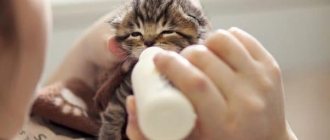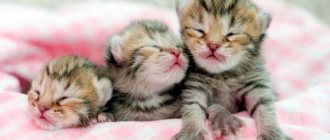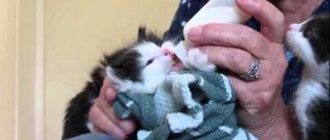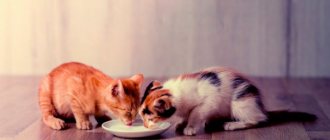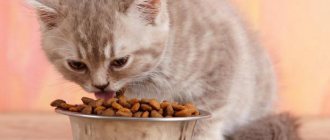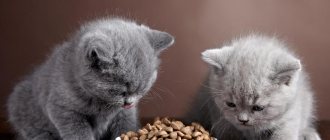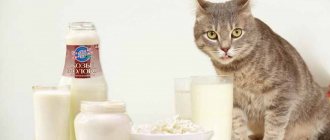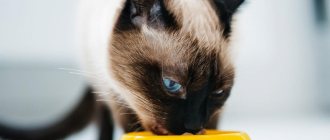How and what to feed a newborn kitten if it is left without a mother cat? The best solution is to find a cat that has recently given birth and place the kittens in her (as a rule, they do not divide kittens into theirs and those of others). By doing this, you relieve yourself of the main problems and then all that remains is to act according to what is written in the books on caring for cats.
It should be taken into account that in the first two days, a cat who gives birth produces colostrum instead of milk, and in small quantities. If your kittens are a little older than the rest, then they should be fed, since at first they may not have enough natural milk. However, it is worth noting that when fed with colostrum in the first days, kittens develop primary immunity. If you can’t find a cat that recently gave birth, you can call a veterinary clinic. There is a possibility that they have such a cat registered. As a last resort, they will explain to you how to feed the kittens and recommend cat milk substitutes.
Feeding regimen for newborn kittens
The most difficult thing in this process is maintaining a schedule, since in order to feed a newborn kitten, you will have to feed them around the clock every two to three hours for four weeks, then they will begin to eat on their own. How often should newborn kittens be fed?
- From days 1 to 13 every two to three hours;
- From days 14 to 24, every two to three hours and one night feeding;
- From days 25 to 35, every three to four hours and one night feeding.
Rules for feeding newborn kittens
How to feed newborn kittens? In the first two to three days, a pipette is used for feeding. But for further feeding, a disposable plastic syringe with a capacity of twenty milliliters is best suited. But you need to use it carefully. It is necessary to feed the contents smoothly and evenly, since if you squeeze the piston, there is a chance that the kitten will choke.
Feeding method
A container with slightly high sides is placed on the table. Fabric folded several times is placed in it, this will make the sides even higher. The kitten is placed in such a way that its hind legs rest against the bottom, while its front legs rest against the sides of your container.
Your elbows are on the table. Place your left hand on the kitten’s back and, holding it by the neck, press your fingers into the bottom of the container. Everything turns out to be more or less stable. In this position, when sucking, the kittens begin to “massage” the wall of the container and after a couple of days they stop showing dissatisfaction with this method of feeding.
What is included in the diet of newborn kittens
What should you feed a newborn kitten without a cat? To independently feed newborn kittens, you should choose a replacement for mother's milk. Such mixtures can be purchased at a pet store. To prepare such a mixture yourself, you need to add ¼ egg white to boiled milk and stir until you get a homogeneous mass.
- From 15 days of age, you can start feeding kittens. Various mixtures and porridges with milk are suitable for this. Do not overheat the milk mixture; it must be warm. To heat the cooled mixture, a water bath is usually used. Do not store the finished mixture for more than 24 hours; it should always be fresh.
- From 21-28 days, you can add protein food to the kittens’ menu. Low-fat cottage cheese, baby meat food, fish, egg yolk, and lean beef are suitable for this.
- From day 35, slowly teach the kitten to eat from a bowl.
How to determine if a kitten is fed enough
Advice! Both overfeeding and underfeeding are dangerous for both a week-old and a two-week-old kitten. We need to find a middle ground. Underfed kittens are lethargic or restless and do not gain weight. When overfeeding, problems with stool appear.
The main indicator of overfeeding is stool
If it is liquid and yellowish in color, this means that there is slight overfeeding.
With moderate overfeeding, the stool takes on shades of green.
Constant overfeeding is the cause of gray stools.
If the stool turns white, a veterinarian should be consulted to rule out infection.
What should you prepare first?
So, you are faced with a difficult question: what to feed a kitten that is less than a month old. Before you get started, you need to make thorough preparations and purchase the necessary supplies and products for feeding.
Necessary kit for a kitten
First of all, you need to purchase auxiliary devices. You will need:
- plastic pipette;
- disposable syringe with a volume of 20 ml;
- catheter;
- pacifier;
- a small bottle with a narrowed spout (for children or intended for drinking kittens);
- measuring spoon;
- convenient bowl.
It is better to take several different pipettes and nipples at once, as some may not be suitable due to poor quality or may not withstand frequent washing. Syringes should also always be in stock.
2 food options
As for feeding small kittens without a mother, the choice of two options is acceptable:
- Artificial ready-made formulas from a pet store or baby formulas.
- The milk mixture you prepared.
The first way of eating is the most convenient, but expensive. Completely ready-to-eat food can be purchased at a veterinary pharmacy or pet store, saving time on its preparation. The use of ready-made infant formulas designed for feeding newborn kittens has also been successfully practiced. You can stock up on this food for a long time.
The second option will significantly save your money, but it will take more time for preparation and feeding procedure. The kittens' nutritional system will change as they grow and include more and more acceptable ingredients.
Feeding with natural products
Natural food for newborns and growing kittens up to 4 weeks of age will consist of solutions of various ingredients. The younger the kitten, the more careful adherence to the proportions and preparation conditions the nutritional mixture will require.
Recipes
The simplest and “lazy” formula recipe for a newborn kitten is available to everyone:
- Boil 4 parts of cow's milk and gradually pour 1 part of egg white into it, stirring continuously until the contents are homogeneous.
- Another “running” recipe will require obtaining a homogeneous mass from:
- 0.5 l milk, 1 egg yolk and 4 tsp. Sahara.
In a similar way, you can prepare more fortified mixtures, similar in nutritional properties to cat milk, which will require the use of a variety of ingredients. The recommended mixtures are also suitable for one-week-old kittens and kittens less than a month old. All of them are prepared on the basis of boiled fresh or concentrated milk. To make it similar in nutritional value to cat milk, it must be mixed with other products (cat milk, compared to cow milk, is almost 10 times richer in proteins). The most popular recipes among cat people are:
- 1 tsp each Stir bone meal and milk and add 5 tsp to the resulting mixture. 20% condensed milk;
- mix 50 mg of whole and boiled milk, add half a raw yolk and 1 tsp. corn oil and beat the mixture thoroughly;
- Mix 1 glass of selected milk with a raw egg and a teaspoon of honey;
- in 200 ml of milk (you can use goat milk instead of cow's), dissolve a teaspoon of vegetable oil, 1 yolk and add to everything 0.4 ml of cat vitamins from a veterinary pharmacy;
- to 100 ml of milk add chicken yolk, half a teaspoon of vegetable oil, 20 ml of 5 percent glucose, 2 tsp. artificial nutrition for newborns, 0.3 ml of vitamins, and mix everything well.
The last 2 recipes are ideal for strengthening an exhausted and weakened body, for example, a kitten found on the street or recovering from an illness.
In the first days, the kitten needs to set a two-hour interval between feedings, gradually increasing it to three hours. The baby should eat approximately 5 mg of the mixture at a time. The dose can be measured using a pipette or syringe. By the age of two weeks it is recommended to increase it 2 times. In the 2nd and 3rd weeks of life, meals are taken every 4 hours. Three-week-old kittens should learn to lap up formula and milk from a bowl on their own 5 times a day.
What to pay attention to when cooking?
The preparation of mixtures and the feeding procedure require a certain diligence and attention on the part of the owner:
- The ingredients included in the nutritional composition must always be fresh;
- They must be mixed especially carefully until a homogeneous mass is obtained, without disturbing the proportions;
- During the first 3 days, it is better to feed a newborn baby using a plastic pipette, carefully holding it at an angle of 45 degrees;
- After 3 days, it will be more convenient to use a disposable syringe without a needle or a bottle;
- All items used during feeding must be washed each time and, if necessary, sterilized;
- By monitoring how much mixture the baby swallows at a time, you can increase or decrease the dosage of food;
- Store the mixture in the refrigerator for no more than 24 hours;
- Before feeding, warm up the food to the optimal temperature (30-36 degrees).
A pet that has reached four weeks of age should begin feeding. For complete nutrition, porridge with milk is gradually introduced into the diet, then cereals are prepared with twisted or finely chopped meat (in a 1:1 ratio) and vegetables in water. Complementary feeding is introduced according to the standard scheme: 200 grams are added per kilogram of live weight per day. You can pamper your pet with healthy cheese and dairy products.
Norms
Below is a table with a detailed description of food products and the frequency of their consumption by a kitten aged 1 - 1.5 months.
| Product type | Frequency of use |
| Lean meat | daily |
| Fish without bones | 1 – 2 times a week |
| Boiled chicken | 3 – 4 times throughout the week |
| By-products | no more than 3 times a week, liver – 1 time a week |
| Egg yolk | no more than 2 times every 7 days |
| Greens (lettuce, spinach) – mixed with cottage cheese | up to 2 times a week |
| Dairy | every day |
| Vegetable oil (a few drops) | in a day |
| Milk porridge | daily |
| Non-acidic cottage cheese | 3 – 4 times a week |
| Vegetables | several times during the week |
| Fermented milk products | every day, cheese - no more than once a week |
| Cereal porridge | several times over 7 days |
| Fresh drinking water | must be available at all times |
Feeding with ready-made formulas
The main advantage of specialized formulas for newborn kittens is that their contents are as similar as possible to the composition of cat milk. In addition, they are divided by age and are intended for kittens:
- newborns;
- weekly;
- menstruation.
You don’t need to invent and develop a diet for different ages yourself. As a bonus, each pack comes with a special, comfortable nipple for feeding. In addition, ready-made food does not cause allergies in cat babies and, if they develop allergies to cow's milk, they must be used. If you decide to switch to feeding ready-made formulas, the only question is which ones are best to purchase.
Of the adapted mixtures for feeding cat babies, veterinarians often recommend a mixture from the famous Dutch company Biafar - Beaphar Kitty-Milk and Royal Canin - Babycat Milk.
- Kitty-Milk is a yellow milk powder mixture with an attractive honey-fruity smell, containing essential vitamins and protein.
- Babycat Milk is an excellent cat's milk substitute, enriched with vitamins and microelements, rich in proteins and oils.
These mixtures are sold in packages, each of which contains 3 hundred-gram bags of instant milk powder, a measuring spoon, a bottle with divisions and nipples with different holes. Preparing them is easy and simple: dissolve 2 scoops of powder in 50 g. warm water. The mixture is stored in the refrigerator for up to 8 hours; when feeding, it warms up to about 40 degrees.
Is it possible to feed a kitten 1–1.5 months old with ready-made food?
Veterinarians and breeders have been arguing for many years about what is better to feed kittens - ready-made food or natural food. One thing is clear - mixing these types of nutrition is extremely undesirable. Some people choose industrial feed for two reasons:
- Saving time (no need to spend time preparing food).
- Ready-made feeds already contain correctly balanced nutrients, minerals and vitamins.
But those who have made their choice in favor of ready-made food need to know the following:
- You need to stick to one diet. If the house has run out of food, you cannot feed the kitten natural food (the baby’s body will suffer). Consequences: gastroenteritis, intestinal obstruction, etc.
- You cannot “jump” from one food to another. Each brand of food has its own recipes and principles (if you mix food from different brands, an imbalance of microelements or, for example, amino acids may occur).
- You need to choose only high-quality food (premium, super premium or holistic).
But not whiskey, not friskas, and not kitiket: there are special flavoring additives, but nothing useful. There is also food in bags or jars. This, of course, cannot be left in a bowl for a long time, but if there is an opportunity to stop by, then eating three times a day will be enough for him until the small one 250 grams per day is enough for him.
Fretka, forum user
https://forum.academ.info/index.php?showtopic=221934
If you decide to feed your kitten ready-made food, then it should be the best food you could find.
If the food is premium or super premium, there should be no problems, if “economy” such as whiskey, friskas, etc. - whatever. In nurseries, all cats on premium food are healthy and shiny, because... there is a balance of vitamins and microelements, and so you have to calculate everything yourself, and if you are not a specialist, then there will be a lack of vitamins or their overdose, which is even worse.
https://bvf.ru/forum/showthread.php?t=970243
Kittens prefer special wet food (canned food in jars or bags, as well as pates). However, dry food is cheaper, and some veterinarians believe that it is also healthier. There is a significant difference between these two types of feed in drinking mode. Wet food is 70-80% water, but dry food requires a lot of water. Month-old kittens fed the so-called “dry” diet are fed porridge from dry food - the granules are soaked in water. Gradually the amount of water is reduced and the amount of feed is increased. The most popular premium and super premium food for kittens are the following brands:
- Eukanuba Puppy Kitten;
- Royal Canin (Size Nutrition Mini Junior or Mother And Babycat);
- Bosch Sanabelle;
- Hill's Science Plan Kitten;
- Almo Nature;
- Pro Plan Junior, etc.
Photo gallery: some types of food for kittens at 1–1.5 months
Almo Nature food for kittens contains at least 50% animal protein and 14% non-allergenic rice
Bosch Sanabel kitten food is produced in Germany, the product composition is well balanced
Eukanuba food contains a lot of proteins, including 43% animal proteins (domestic chicken)
Hill's is famous for its rich composition of vitamins and minerals, but it may contain a large percentage of difficult-to-digest carbohydrates
“Proplan” can be bought in almost any pet store; it is very popular among Russian breeders.
Seeing the price tag on the packaging of good food, the owner of a kitten may change his mind. But these numbers seem large only at first glance. After all, you don’t need to give a lot of good food (the kitten won’t remain hungry anyway), and with a balanced diet, you don’t need to buy any additional products (all vitamins are already included in the product).
Akana Grasslands food: A bag of Akana costs 2,250 rubles per 7 kg bag. 7 kg for two kittens for 55 days. The total weight of kittens is 5.72 kg 63.5 g per kitten per day. 1.972 kg per month per kitten. 22.2 g per kilogram of kitten per day. 690 g per kilogram of kitten per month. 20 rubles per kitten per day. 630 rubles per kitten per month.
Squirreland, regular forum visitor
https://forum-wec.com/index.php?showtopic=170823
Of course, a large package of food is always more profitable than several small ones. However, here you should take into account the number of kittens, the amount of food they consume per day and the shelf life of the product. I try to take medium-sized packages, since the food may run out before the kittens eat it. It is advisable to choose the packaging that has the latest production date.
What should you not feed newborn kittens?
There are several rules that owners of small animals must strictly adhere to. So, what exactly should you not feed a newborn kitten?
Firstly, it is necessary to constantly follow the schedule, dosage and feeding rules.
Secondly, it is not recommended:
- Feed newborn kittens with cow's milk in its pure form, as it is very poorly digested, and the animal can die from indigestion;
- Giving the baby milk or cream diluted with water is harmful to the baby’s health;
- Give your pet fatty dairy products;
- Feed him with sausages and pork in any form;
- Using raw freshwater fish fillets in your diet may result in infection with helminths.
What does a kitten need to grow?
Receiving nutrition from liver glycogen, newly born kittens can go without food for the first few hours, while underdevelopment of the sucking reflex and incomplete activation of digestive functions are observed. On average, the weight of newborn kittens ranges from eighty to one hundred and twenty grams.
The following dynamics are characteristic of normal growth: their weight doubles after the first week, then the weight gain is approximately one hundred grams. The average weight of a two-month-old kitten can reach 1-1.3 kilograms.
The umbilical cord usually dries out on the second day, and after three or four days it falls off. After seven to fourteen days, the kittens' eyes begin to water, and by the appearance of a dark edging around the closed eyelids, it can be assumed that the babies will soon open their eyes. As a rule, this happens within two to three days. First one eye opens, and then the second. If necessary, they are washed with a diluted chamomile decoction. Remember that the more time you spend with your kittens in the first weeks of their lives, the better they will feel later on.
Because for a grown kitten, you will remain the only and beloved “mother” until the end of your days.
Warmth and comfort
The temperature in the kitten house should be about 28-30 degrees C. A cardboard box measuring forty by fifty centimeters is suitable for this. Until the eyes open, about two weeks, the box must be closed and the kittens kept in the dark. At the same time, after opening your eyes, do not expose them to bright light. And when feeding, you should slightly close the curtains and turn on the light.
One heating pad should be placed on four sides of the box. Glass bottles with a capacity of 0.5-0.6 liters are suitable for this. Every five to six hours, boiling water is poured into them, while they are wrapped in a terry towel in 5-6 layers. You should not use a linen towel because it transfers heat and wool too much, as kittens can become entangled in the threads pulled out by the claws. With this heating, if the walls are hot, the kittens sleep in the center of the box.
And vice versa, if they have gathered in any of the corners, then you need to pour boiling water into the heating pads again. This should be combined with the next feeding, since there is no need to wake the kittens up again. So that they can move easily, you need to lay a smooth cloth on the bottom of the box.
Hygiene
During each feeding it is necessary to carefully examine the kittens. Take a hard cloth slightly moistened with warm water, linen is suitable for this, and gently wipe the kitten’s ears, head, back, sides and paws. This imitates the process of a cat washing itself.
Next you need to massage the tummy and force the kitten to urinate by massaging the surface on the inner thighs around the urethra. As a rule, there are no difficulties with this. If the rules for care and feeding are followed, once every two or three days, kittens walk around.
What will you need for self-feeding?
To feed a small newborn kitten, you should purchase special equipment:
- A pacifier, but definitely not a baby one . You will need a special one, which can be purchased at a pet store or veterinary pharmacy. But the baby is fed without a pacifier; it will be needed a little later.
- Pipette . This is the best option for feeding the animal. Its convenience is that food can be served in doses and the volume can be clearly calculated. However, the pipette should be used carefully, since air entering it can cause severe bloating in the baby.
- Spoon - theoretically, a kitten can be taught to eat mixture from a spoon, but this method of feeding contributes to the suppression of sucking reflexes.
- Syringe – used without a tip (needle). This device is considered the most convenient and easy to use. The syringe's nose resembles a cat's nipple and helps develop conditioned reflexes.
Bottles. Pet stores sell special feeding bottles. However, they all have standard universal sizes, so they are not suitable for all breeds of kittens. Owners will need to select an individual size:
- When you turn the bottle over, milk flows out. This indicates that the hole diameter is too large. Intensely leaking milk threatens the kitten with choking.
- The milk comes out of the container only after pressing on it - the hole has an insufficient diameter, so the milk comes out with difficulty, because of this the kitten will not be able to suck it. Such inconvenience for the animal will lead to it refusing to eat.
- The ideal hole size is that the milk drips slowly when you lightly press the sides of the bottle.
It is important to immediately select the correct hole diameter for the kitten.
The animal will quickly get used to a certain type of nipple, and replacing it can lead to a complete refusal to eat from the bottle. It is difficult for a person to replace a mother cat for a newborn kitten. But if you put maximum effort and attention into the process, it will turn out very well.
Special feeding tube
This device is used if it is not possible to awaken the baby’s sucking reflex, accordingly, other methods of feeding are impossible, or the animal is too weak to suck on its own.
Using a special tube is the cleanest and most hygienic method of feeding kittens. But using this device requires a certain skill and extreme care. Disadvantages of using a tube:
- There is no way to control the amount of food, which is why the kitten receives too much of it (extremely bad for digestion) or, conversely, not enough.
- If the baby has a well-developed sucking reflex, but cannot satisfy it due to the lack of a pacifier or syringe, he begins to “suck” the fur of another kitten or his own. He does this too intensely, which can lead to serious skin diseases.
Algorithm for using the handset:
- Open your pet's jaw by pressing on it with your fingers. Before inserting the tube into the esophagus, it must be lubricated with a special product, for example, KY jelly.
- Hold the kitten's head straight while pushing the tube down the esophagus. You need to slide across the sky, moving the device along the back wall of the esophagus.
- The tube should be advanced until the mark on the hose is equal to the level of the nose - it has reached the esophagus.
- Connect a syringe with the nutritional mixture to the tube. It is recommended to press the piston slowly and carefully.
How to make a mark? The distance from the animal's nose to the last rib is measured. The mark is needed in order to insert the tube correctly, directly into the stomach.
Risk of improper use of the tube. You cannot use the tube without certain knowledge and skills. When deciding to feed a kitten with a special device, you must consult with a veterinarian who will demonstrate the correct use of this device.
Incorrect technique for using the tube carries the risk of it getting into the respiratory tract. If the kitten squeaks while feeding, it means that the tube has entered the stomach without touching the respiratory organs. Given the difficulty of tube feeding kittens, this method is mostly used by breeders.
